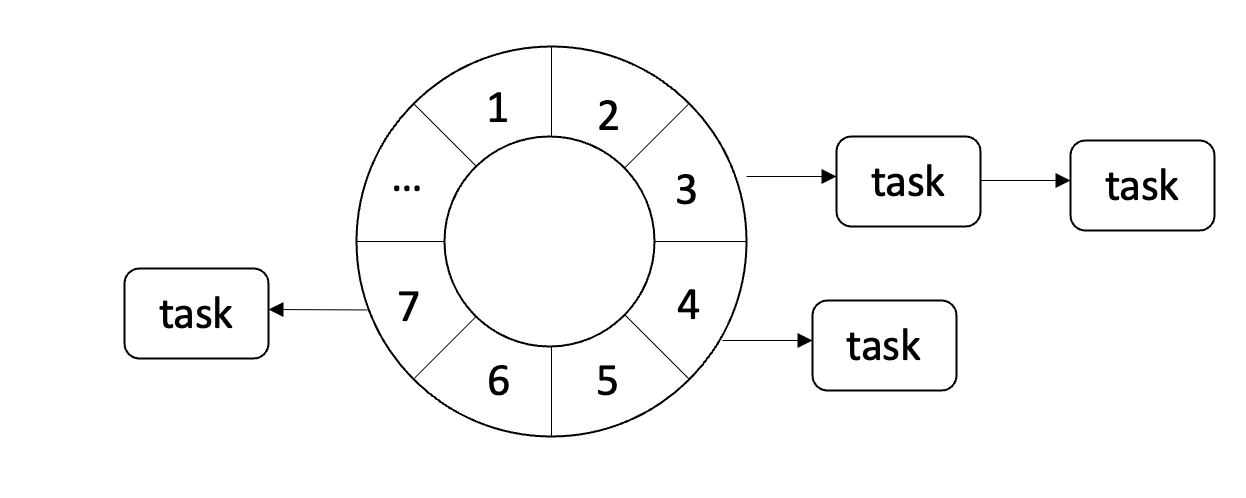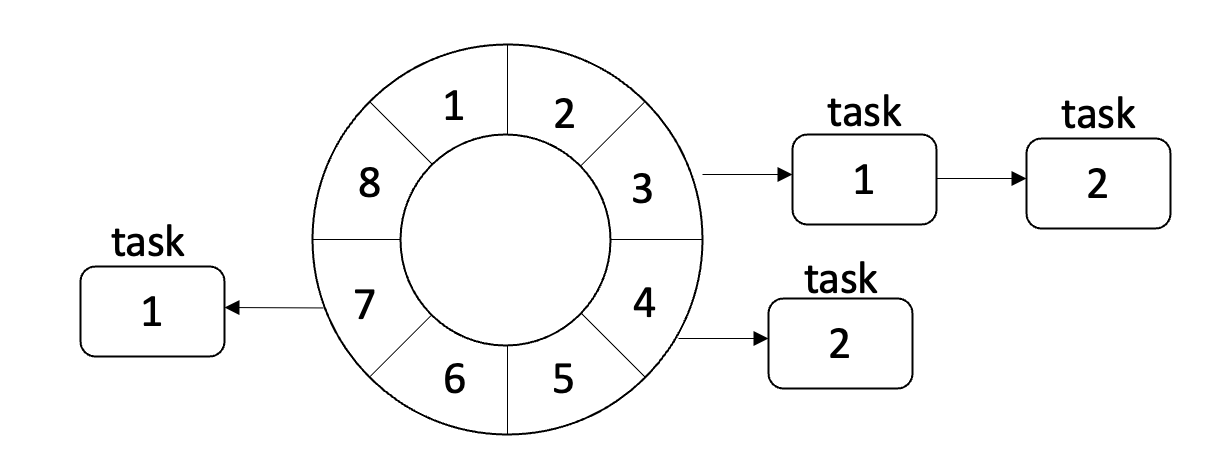netty 系列之:HashedWheelTimer 一种定时器的高效实现

简介
定时器是一种在实际的应用中非常常见和有效的一种工具,其原理就是把要执行的任务按照执行时间的顺序进行排序,然后在特定的时间进行执行。JAVA 提供了 java.util.Timer 和 java.util.concurrent.ScheduledThreadPoolExecutor 等多种 Timer 工具,但是这些工具在执行效率上面还是有些缺陷,于是 netty 提供了 HashedWheelTimer,一个优化的 Timer 类。
一起来看看 netty 的 Timer 有何不同吧。
java.util.Timer
Timer 是 JAVA 在 1.3 中引入的。所有的任务都存储在它里面的 TaskQueue 中:
TaskQueue 的底层是一个 TimerTask 的数组,用于存储要执行的任务。
看起来 TimerTask 只是一个数组,但是 Timer 将这个 queue 做成了一个平衡二叉堆。
当添加一个 TimerTask 的时候,会插入到 Queue 的最后面,然后调用 fixup 方法进行再平衡:
当从 heap 中移出运行的任务时候,会调用 fixDown 方法进行再平衡:
fixup 的原理就是将当前的节点和它的父节点进行比较,如果小于父节点就和父节点进行交互,然后遍历进行这个过程:
fixDown 的原理是比较当前节点和它的子节点,如果当前节点大于子节点,则将其降级:
二叉平衡堆的算法这里不做详细的介绍。大家可以自行查找相关的文章。
java.util.concurrent.ScheduledThreadPoolExecutor
虽然 Timer 已经很好用了,并且是线程安全的,但是对于 Timer 来说,想要提交任务的话需要创建一个 TimerTask 类,用来封装具体的任务,不是很通用。
所以 JDK 在 5.0 中引入了一个更加通用的 ScheduledThreadPoolExecutor,这是一个线程池使用多线程来执行具体的任务。当线程池中的线程个数等于 1 的时候,ScheduledThreadPoolExecutor 就等同于 Timer。
ScheduledThreadPoolExecutor 中进行任务保存的是一个 DelayedWorkQueue。
DelayedWorkQueue 和 DelayQueue,PriorityQueue 一样都是一个基于堆的数据结构。
因为堆需要不断的进行 siftUp 和 siftDown 再平衡操作,所以它的时间复杂度是 O(log n)。
下面是 DelayedWorkQueue 的 shiftUp 和 siftDown 的实现代码:
HashedWheelTimer
因为 Timer 和 ScheduledThreadPoolExecutor 底层都是基于堆结构的。虽然 ScheduledThreadPoolExecutor 对 Timer 进行了改进,但是他们两个的效率是差不多的。
那么有没有更加高效的方法呢?比如 O(1)是不是可以达到呢?
我们知道 Hash 可以实现高效的 O(1)查找,想象一下假如我们有一个无限刻度的钟表,然后把要执行的任务按照间隔时间长短的顺序分配到这些刻度中,每当钟表移动一个刻度,即可以执行这个刻度中对应的任务,如下图所示:

这种算法叫做 Simple Timing Wheel 算法。
但是这种算法是理论上的算法,因为不可能为所有的间隔长度都分配对应的刻度。这样会耗费大量的无效内存空间。
所以我们可以做个折中方案,将间隔时间的长度先用 hash 进行处理。这样就可以缩短间隔时间的基数,如下图所示:

这个例子中,我们选择 8 作为基数,间隔时间除以 8,余数作为 hash 的位置,商作为节点的值。
每次遍历轮询的时候,将节点的值减一。当节点的值为 0 的时候,就表示该节点可以取出执行了。
这种算法就叫做 HashedWheelTimer。
netty 提供了这种算法的实现:
HashedWheelTimer 使用 HashedWheelBucket 数组来存储具体的 TimerTask:
首先来看下创建 wheel 的方法:
我们可以自定义 wheel 中 ticks 的大小,但是 ticksPerWheel 不能超过 2^30。
然后将 ticksPerWheel 的数值进行调整,到 2 的整数倍。
然后创建 ticksPerWheel 个元素的 HashedWheelBucket 数组。
这里要注意,虽然整体的 wheel 是一个 hash 结构,但是 wheel 中的每个元素,也就是 HashedWheelBucket 是一个链式结构。
HashedWheelBucket 中的每个元素都是一个 HashedWheelTimeout. HashedWheelTimeout 中有一个 remainingRounds 属性用来记录这个 Timeout 元素还会在 Bucket 中保存多久。
总结
netty 中的 HashedWheelTimer 可以实现更高效的 Timer 功能,大家用起来吧。
更多内容请参考 http://www.flydean.com/50-netty-hashed-wheel-timer/
最通俗的解读,最深刻的干货,最简洁的教程,众多你不知道的小技巧等你来发现!
欢迎关注我的公众号:「程序那些事」,懂技术,更懂你!
版权声明: 本文为 InfoQ 作者【程序那些事】的原创文章。
原文链接:【http://xie.infoq.cn/article/a0cdbcef280f28f58ad136266】。文章转载请联系作者。











评论